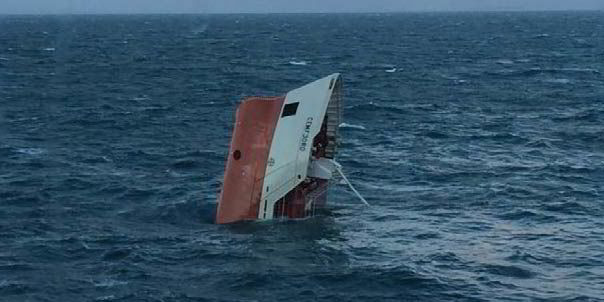A UK accident report has found that a German cement carrier was lost with all eight crew after the captain ploughed straight into a severe storm.
The fully-laden 2,327-dwt Cemfjord (built 1984) capsized on 2 January, 2015, in the Pentland Firth, Scotland, and later sank. Seven Poles and a Filipino died.
The UK Marine Accident Investigation Branch (MAIB) said the rapid nature of the capsize denied the crew an opportunity to issue a distress message or the chance to conduct a controlled abandonment of the vessel, which was flagged in Cyprus.
“The extraordinarily violent and fatal sea conditions encountered in the Pentland Firth were predictable and could have been avoided,” it added.
“As well as insufficient passage planning, the master’s decision to press ahead with the voyage, rather than seek shelter, was almost certainly influenced by an underestimation of the severity of the conditions, his personal determination to succeed and an unwillingness to turn the vessel across the heavy sea.”
Steve Clinch, chief inspector of marine accidents, said the reluctance to turn across was likely to have been influenced by the experience of a cement cargo shift in similar circumstances about three months before the accident.
MAIB said: “This tragic accident is a stark reminder of the hazards faced by mariners at sea and the factors that can influence decision making in such treacherous circumstances.”
Ship vulnerable to capsize
MAIB also found that it was likely Cemfjord’s stability condition did not meet the required criteria, making the vessel more vulnerable to capsize.
“Cemfjord was at sea with significant safety shortcomings; there is no evidence that any consideration was given to delaying departure until these problems were fixed,” it said.
“Instead, flag state exemptions from safety regulations were approved to allow the ship to proceed to sea.”
This was not a factor in the accident however.
Shortcomings related to its rescue boat launching arrangements and bilge pumping system in the void spaces beneath the cement cargo holds.
However, the exemption regarding the rescue boat was not applicable to the equipment on board, MAIB found.
“This resulted from misunderstandings caused by the imprecise nature of the communication between the vessel’s managers, the flag state and the flag state’s recognised organisation,” it added.
The report said the flag state’s process for managing requests for exemptions from international safety regulations was also found to lack rigour.
Additionally, flag state inspections of the vessel over many years in Poland were "ineffective and did not deliver the intended levels of assurance."
Since the accident, manager Brise Bereederungs has made several changes aimed at improving the safe operation of its fleet and the safety culture of its crews, MAIB said.
“The changes include enhancements to its vessels’ stability management and weather forecasting capabilities in order to aid passage planning.”
Cyprus meanwhile has introduced a new process for managing requests from shipping companies for flag state exemptions from international safety regulations.




